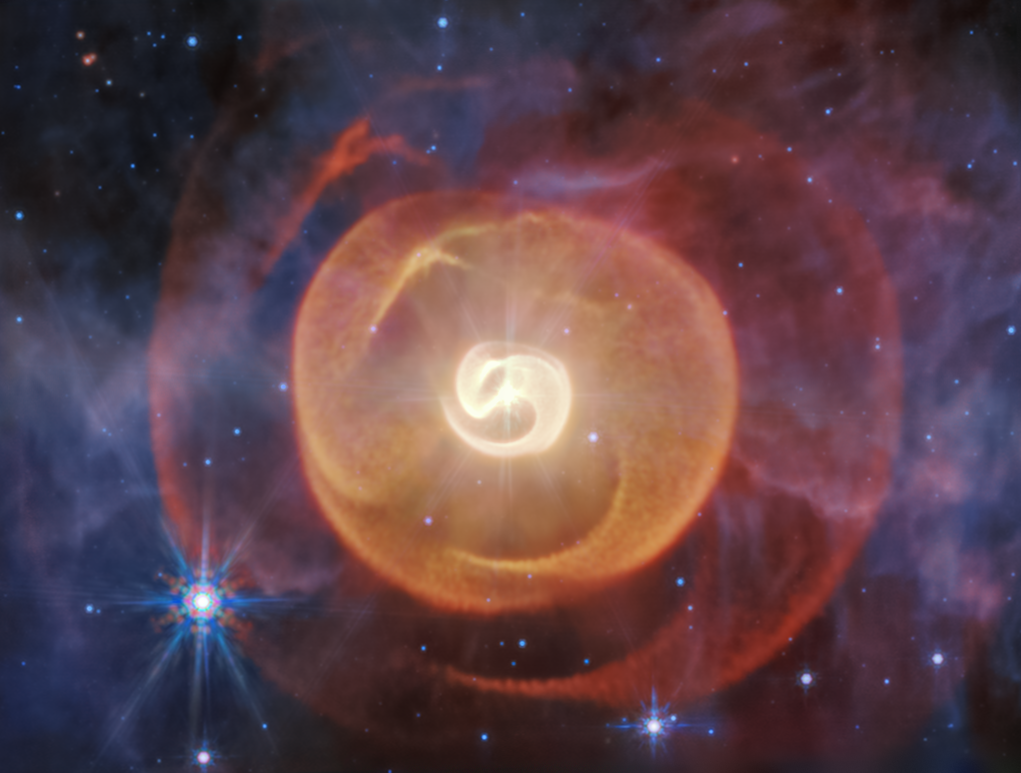
NASA’s James Webb Space Telescope has achieved a groundbreaking discovery: a detailed mid-infrared image revealing a system of four spiraling dust shells around the Apep star system. This discovery marks the first time these structures have been observed, with previous observations only detecting a single shell. The shells, which have been expanding over the last 700 years, are produced by two aging Wolf-Rayet stars within the system, named after the Egyptian god of chaos, Apep.
The observation, combining data from Webb and the European Southern Observatory’s Very Large Telescope (VLT) in Chile, has refined our understanding of the stars’ orbits. The two Wolf-Rayet stars orbit each other once every 190 years, with a close approach lasting 25 years during which they form dust. This discovery not only highlights the system’s complexity but also confirms the presence of a third massive supergiant star that influences the dust’s formation.
Unveiling the Dusty Secrets of Apep
Webb’s image offers unprecedented clarity, showing the intricate patterns of dust cast off by the stars. “Looking at Webb’s new observations was like walking into a dark room and switching on the light – everything came into view,” said Yinuo Han, lead author of a paper in The Astrophysical Journal and a postdoctoral researcher at Caltech. The image reveals that the dust is structured in repetitive, predictable formations, a finding that aligns with the publication of another paper by Ryan White, a PhD student at Macquarie University.
By combining Webb’s precise imaging with the VLT’s long-term observations, Han, White, and their colleagues have refined the known orbital dynamics of the Wolf-Rayet stars. “This is a one-of-a-kind system with an incredibly rare orbital period,” White explained. The next longest known orbit for a dusty Wolf-Rayet binary is about 30 years, with most ranging between two and ten years.
The High-Speed Dance of Dust
The dust-producing Wolf-Rayet stars in Apep are not only rare but are also moving at incredible speeds, ejecting dust at 1,200 to 2,000 miles per second. The dust’s composition, primarily amorphous carbon, allows it to retain heat even as it travels far from the stars. This property makes the dust detectable by Webb’s Mid-Infrared Instrument (MIRI), despite its faint emission.
The third star in the system, a massive supergiant, plays a crucial role by carving holes into the expanding dust clouds. “The cavity is more or less in the same place in each shell and looks like a funnel,” White noted. This discovery was made possible by Webb’s ability to provide a ‘smoking gun’ confirming the gravitational binding of the third star to the system.
Future Prospects and Cosmic Implications
The future of the Apep system is as dynamic as its present. The Wolf-Rayet stars, initially more massive than their supergiant companion, have shed significant mass and are likely to explode as supernovae. This event could potentially lead to a gamma-ray burst, one of the universe’s most powerful phenomena, before the stars possibly become black holes.
Wolf-Rayet stars are exceedingly rare, with only about a thousand estimated in the Milky Way galaxy. Apep stands out as the only known example in our galaxy with two Wolf-Rayet stars of this type, making it a unique subject of study.
The James Webb Space Telescope continues to be a pivotal tool in unraveling the mysteries of our universe. As an international program led by NASA, with partners ESA and CSA, Webb is not only exploring our solar system but also distant worlds and cosmic structures, enhancing our understanding of the universe and our place within it.







